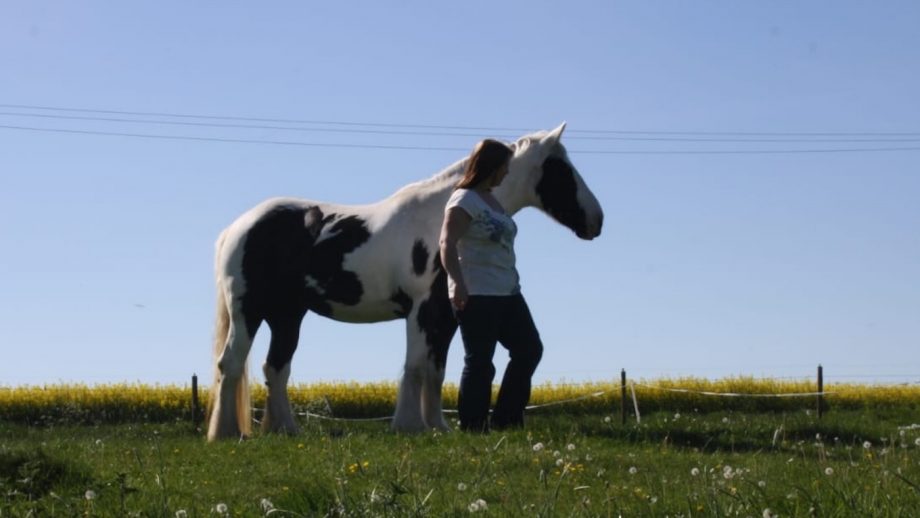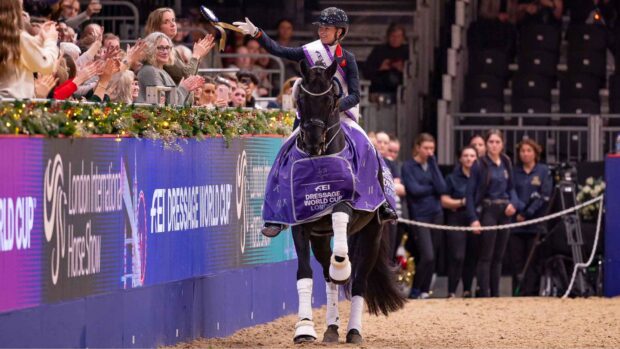A rider who has lost her horse, her job and her life as she knew it to motor neurone disease (MND) is urging others to back calls for increased Government research funding.
Emma Moss, who was diagnosed nearly three years ago, now relies on a ventilator to breathe, has no movement in her legs and needs 24-hour care. The last time she rode her horse Liv was five years ago, but she can remember every minute.
“It hurts to think about her, but I do,” Emma told H&H. “The strength of feeling is such that it’s very painful; it’s such a strong connection with the physical life I’ve lost.”
Sign the Government petition here
Emma, now 40, started riding in her early 20s, and loved “charging around the countryside”, as well as the whole experience and lifestyle of being around horses. Having loaned horses, she started looking for one to buy in 2010.
“The search was interesting,” she said. “I’d call about a horse, go and ride it,and there would always be a call to a friend or my instructor afterwards, to say ‘what do you think?’ or that I wasn’t sure about this or that. The one I ended up buying, I kept seeing her ad and thinking she wasn’t for me but on paper, she sounded right so I went to see her. That was the first time I didn’t call anyone afterwards.
“It makes me feel really emotional, thinking back to that first ride. I didn’t have great confidence and she was bouncing and charging about, and strong but I had a smile on my face the whole time. I got off and said ‘I want to take her home’. People talk about their heart horse, or horse of a lifetime, and that’s exactly what she was.”
Emma described riding and caring for Liv as her peace around her job as a deputy headteacher. She stopped riding when she was undergoing IVF treatment, and noticed her first symptoms soon after the birth of her daughter Veryan, who is now four.
“My thigh muscles started twitching, violently and constantly,” she said. “Looking back, it was so obvious something was devastatingly wrong.”
Emma then noticed her grip was weakening; she had to ask her husband Terry to do up Veryan’s babygros as she did not have the strength in her hands.
Doctors said she was deficient in vitamin D, but by the time she went back to work, she was struggling to walk and climb steps. Doctors then suspected carpal tunnel syndrome.
“I went for an appointment and had a needle test into the muscle,” she said. “He tested my elbow, leg, shoulders, then he asked if I had trouble swallowing, and it was like time stood still; like a game of Tetris when everything falls into place. The nurse came over and held my hand, and all I could say was ‘I don’t want to die, I don’t want to die’. I’d gone to the appointment on my own as I thought it was just routine, and left in hysterics. I got into my car and screamed.”
Log into Facebook
Log into Facebook to start sharing and connecting with your friends, family, and people you know.
Within 24 hours, Emma had her diagnosis.
“I knew it was terminal; I knew it was bad, but I didn’t know how bad, or how quickly it kills most people,” she said. “I didn’t know it was the most feared disease among health professionals, or that there’s nothing that can be done about it.”
In MND, the motor neurons, cells in the brain and spinal cord that take the brain’s commands to the muscles, progressively stop working. This means movement, breathing, swallowing and speech become worse over time. Life expectancy for about half of those with the condition is three years from the start of symptoms.
“There seem to be people who want to know exactly how long they’ve got, but I said from the outset that I didn’t want to talk about that,” Emma said. “I want to do everything in my power to live. Something like 60% of people who go to Dignitas are MND patients, because it’s that hard, that terrifying and that awful to live with. But I said I’ll be doing nothing to hasten my death, and everything to prevent it. I want to live at all costs — for Veryan.”
A fund has been set up to support Emma’s family here
The petition is calling for the Government to increase its funding of MND research to £50m over five years. If 100,000 people sign it, the Government has to consider the issue for debate. Emma also has a meeting with Government this month; the greater the number of people who sign, the clearer the message will be.
“MND will happen to about one in 300 people,” Emma said. “It’s devastated lives for decades — it’s destroyed my life — and it’s something money can help with, but it’s desperately under-funded.
“Because MND is so awful, it’s shied away from; people don’t want to face the reality that this could happen to them. At the moment, there’s just over £3m in Government funding for MND research and the amount we’re asking for could super-charge the research. It would make a huge difference, as it’s not incurable, it’s under-funded.”
Emma cited a developing gene therapy treatment, which has appeared essentially to halt progression in patients with one rarer form of MND.
“That’s transformational,” she said. “It’s a miracle for the people with that form. They’re only 1% of cases but it proves that things can be done, we just need the money.
“This isn’t about myself, for me, all of my pain really is Veryan. I wanted her to have everything. When I think of the future I had planned for her; my friend has a Shetland called Twitchy who was always going to come to us, it’s so painful to think of how we could have been. But if it gets to the stage where I can’t move a single muscle, I know I’ll still be able to communicate through my eye gaze technology, so I’ll still be able to have an influence on her life.
Continues below…

Subscribe to Horse & Hound magazine today – and enjoy unlimited website access all year round
“When I get angry, about being in pain or uncomfortable, I almost tell myself I’m lucky to be feeling that. I could be dead, but even uncomfortable, in pain, frustrated — I’m still lucky and glad to be alive.”
Emma vividly remembers her last ride.
“I can feel every part of it,” she said. “I can hear the conversation I had with my yard owner as she held my stirrup; it feels so far away but as if it was only yesterday.
“A message I’d love to get across is: seize the day, ride when you can. I spent months out of the saddle with Liv, and although I did ride a lot, there were times I found a reason not to, and that’s a huge regret.
“In my dreams, I can still ride. And it’s always at a canter.”
Horse & Hound magazine, out every Thursday, is packed with all the latest news and reports, as well as interviews, specials, nostalgia, vet and training advice. Find how you can enjoy the magazine delivered to your door every week, plus options to upgrade to access our H&H Plus online service which brings you breaking news as it happens as well as other benefits.




